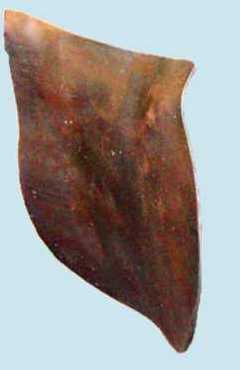|
By Jerry Tardif
So, you've got a piece of curled leather on your saddle or other piece of tack that you want to straighten.
Of course, you already know that the best way to prolong the life of leather tack is to take regular care of it.
Keep it clean, dry it quickly when it gets wet, and oil it lightly, but regularly to maintain its water resistance properties.
You also want to keep it in a fairly dry, warm space as opposed to the temperature and humidity vagaries of a basement, attic, or unheated barn.

Bent, Mottled, Leather Leg Guard
|
But the fact you already know all this stuff is irrelevant, isn't it?
Because you've got a piece of curled leather on your saddle or other piece of tack that you want to straighten.
In that case, you have only three real options:
- Get someone to try to fix it;
- Replace the piece yourself; or
- Try to flatten it yourself.
If you decide to try flattening, you need to understand there is some risk that you might actually make the problem worse or ruin the piece altogether.
Of course, if the piece is already in bad shape, you have little to lose.
But make sure it's not in such bad shape that attempting to restore it isn't even possible or worth it.
|
Leather is routinely flattened commercially in the furniture industry.
It's done for two reasons: 1) to make the leather flat, obviously, and 2) to hide imperfections.
The latter is addressed by putting the leather under high pressure beneath a heated plate (in fact, the process is called "plating").
The heat and pressure make the surface smooth and remove imperfections.
To "press" leather, place the leather face-down on a heat-tolerant pad, such as an ironing pad used on ironing boards.
That leaves the rough side up.
Cover it with a press cloth, usually brown paper, and apply heat from a clothes iron.
Start with a low heat setting; you want the entire piece of leather under the iron to heat evenly.
Too high a setting will heat the surface faster and can actually increase the curl.
When the leather is very warm, but not too hot too touch, stop heating, remove the paper, and cover the leather with a heavy weight, such as a large book (the hardcover edition of War and Peace works well — alternatively, use several other, heavy books if your copy of War and Peace is currently being read by a friend).
BE CAREFUL!
If you overdue it, you'll make the leather dry and prone to cracking — then you'll need to discard it and get a same-colored piece of leather for a replacement — not easy!
You don't want to dry the leather out, just soften it and make it susceptible to pressing.
I've heard of some people using a steam iron with the steam, but have never tried it.
If you're going to be doing any leather flattening at all, I STRONGLY suggest that you go to a local leather store and purchase a few pieces of leather, hopefully curled.
In fact, if they are curled, the store may just give them to you — you only need scraps several inches by several inches to do your testing.
So just ask for scraps from the outset.
Mention what you're doing and they may be able to give you some additional suggestions.
For them, it's cheaper to discard scraps and start with new.
But if they do leather reconditioning, the customer will want to refurbish and not replace an existing leather piece, so they must use some form of pressing to achieve that goal.
They may even offer to do the job for you at a reasonable price.
Besides being an avid trail rider, Jerry Tardif is a technology consultant and a horse and nature photographer in SE Connecticut — see his work at: www.jerrytardif.com.
He is also co-founder and President of QueryHorse.
Back to Article Index
|